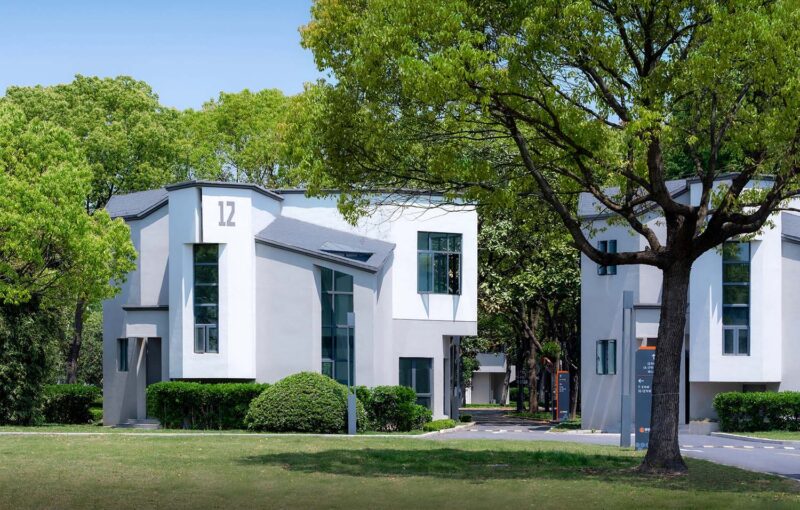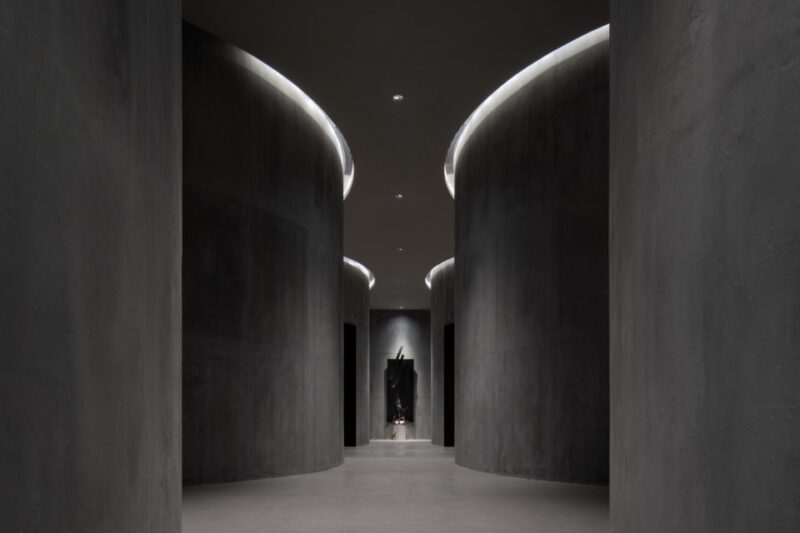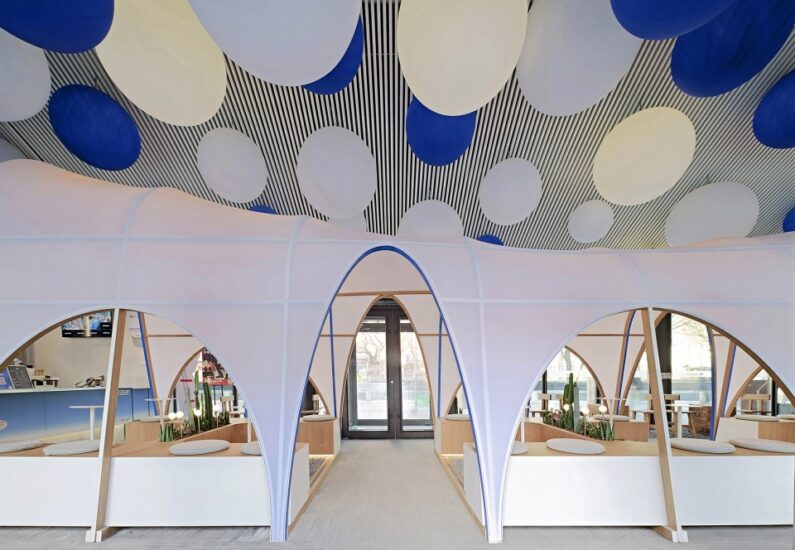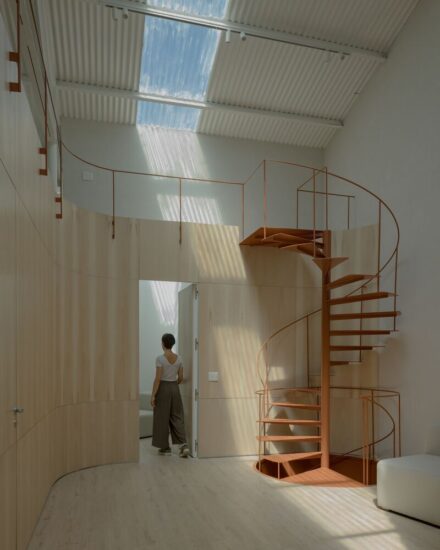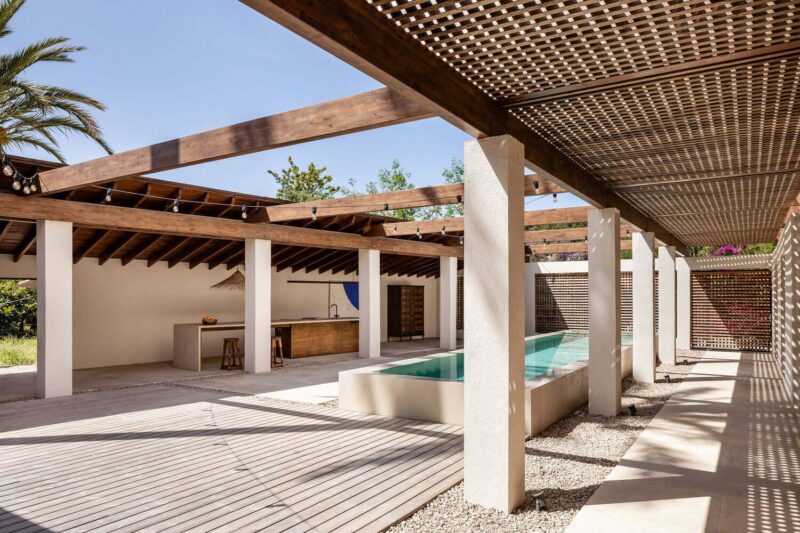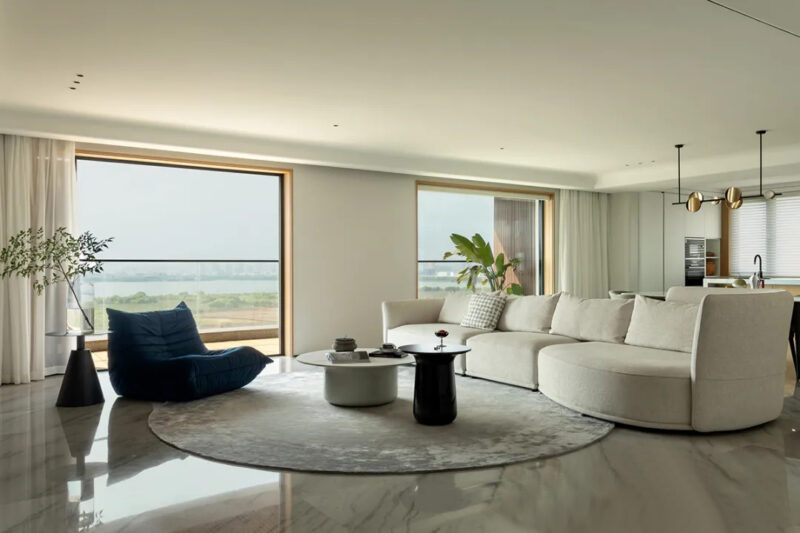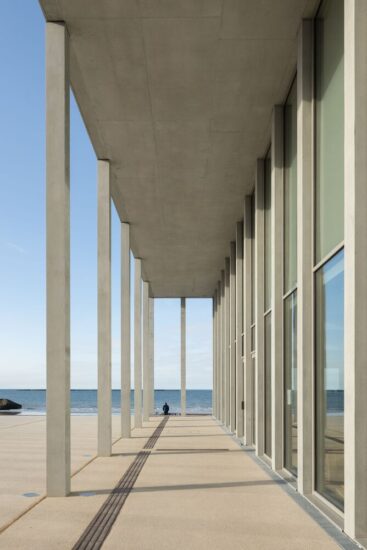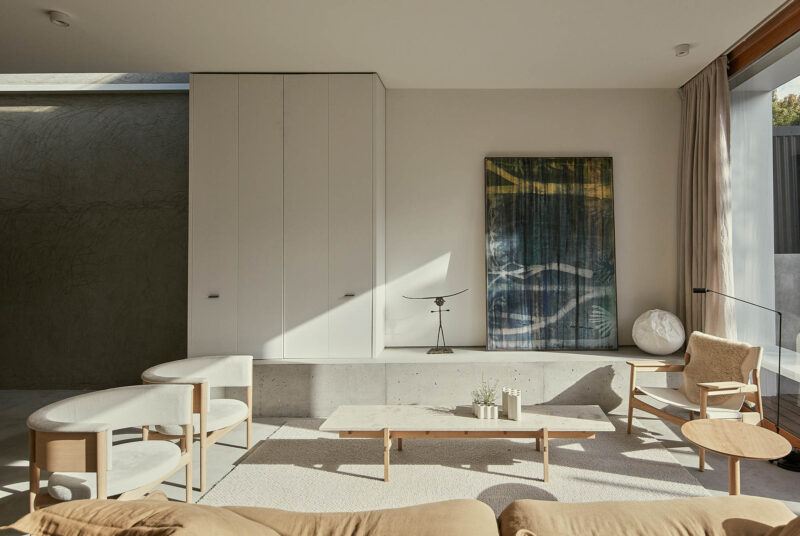章太炎故居改造:国学文化与苏州记忆的空间容器
Renovation of the Former Residence of Zhang Taiyan by Tsing-Tien Making
A spatial container of Chinese classics and memories about Suzhou
“改造不是一味地融入仿旧,而是通过古与新的重叠,赋予这座老洋房新的语言,从设计到功能,再到访客。我们希望章太炎先生的故事,不仅仅停留在那个时间,还能够融入当代故事,不断生长,走向未来。”——青天制作所
“Renovation is not simply about blending into the old. Instead, it involves the fusion of the old and the new to imbue this long-standing house a new language, from design to functionality and the experience it offers to visitors. We hope the story of Zhang Taiyan and his house do not stop in that specific time period but to continue, with the new memory and language, to carry forward.”By Tsing-Tien Making
∇ © 汪敏杰 © Minjie Wang
一座姑苏城,半部江南诗。从古城区锦帆路走过,可以看到不少古朴典雅的老宅,这里曾是苏州子城,青砖平瓦下,沉淀着书画之地的底蕴和风骨。坐落于锦帆路38号的章园便是这个街区一处颇具价值的文化印迹,这座宅子始建于1932年,是国学泰斗章太炎晚年藏书、著述、会客和生活起居之所。2023年,古吴轩书店接手运营,委托青天制作所主持设计这座百年老宅,将其改造为古吴轩书店和故居博物馆后,正式对公众开放。
The enchanting city of Suzhou encapsulates the poetic beauty of the Southern Yangtze region. A stroll along the historic Jinfan Road in the city’s old neighborhoods reveals numerous quaint and elegant old residences. Once the heart of Suzhou, this area, adorned with gray bricks and flat tiles, embodies the profound cultural heritage and charm of a place steeped in the arts of calligraphy and painting. Among these treasures stands the Zhang Garden, located at No.38 Jinfan Road, a valuable cultural landmark in this neighborhood. Constructed in 1932, this residence belonged to an eminent scholar of Chinese nationalism named Zhang Taiyan. In his late years, Zhang housed his collection, engaged in writing, received guests, and lived in this residence. In 2023, Gu Wu Xuan Bookstore took over its operation and entrusted Tsing-Tien Making to renovate this century-old mansion into a bookstore and a museum based on the scholar’s former residence. In the same year, it officially opened to the public.
∇ © 蒋世颖 © Shiying Jiang
场地内由3栋民国老洋房组成,建筑外立面呈现中西合璧的风格,清水砖墙、苏式木花窗、中式亭廊与罗马柱结合。近600平米的南楼规划为故居博物馆,北面占地约880平米的两栋北建筑则是此次书店的主体部分。
The site comprises three mixed-style houses built during the Republican period (1911-1949), showcasing a harmonious blend of Chinese and Western architectural styles in the facades. The exterior features plain brick walls, Suzhou-style wooden lattice windows, Chinese-style pavilions, and Roman columns. The southern building, spanning nearly 600 square meters, is designated as the residence-based museum, while the two northern buildings, occupying approximately 880 square meters, constitute the main section of the bookstore.
∇ 章园整体轴测图 © 青天制作所
The axonometric drawing of the Zhang Garden © Tsing-Tien Making
∇ 鸟瞰 © 袁炜、王文斌 Aerial view © Wei Yuan, Wenbin Wang
∇ © 蒋世颖 © Shiying Jiang
#01场地原貌
Site Conditions
在青天制作所接手章园的设计前,故居的整体面貌由古建保护修缮加固好后交接。待交接现场勘测后,发现整体存在几个问题和限制:
1、章太炎故居系江苏省文物保护单位,对此次改造的限制较为严格;
2、将1930年代的私人住宅转换成今后对公众开放的书店,原有的开间、布局、动线存在明显问题,会影响日后使用;
3、室内面宽有限且进深较深,采光存在问题;
4、原有建筑材料和风貌,在修缮过程中受到了折损;
5、墙体和柱子经过先前多次叠加修缮后,数据不准确且非直线;
6、景观过于直白,园子大门口就将整个庭院收入眼底,缺少了苏式园林本该有的委婉。
Before Tsing-Tien Making took charge of the project, the overall appearance of the residence had undergone comprehensive conservation and reinforcement. However, upon site survey, several issues and constraints were identified:
1.Zhang Taiyan’s former residence is a protected cultural heritage site of Jiangsu Province. The government imposed stringent limitations on its renovation.
2.The original room size, layout and circulation presented evident challenges for converting the 1930s private residence into apublicbookstore, which could affect future use.
3.The limited space width and considerable depth of the interior posed challenges to natural daylighting.
4.The original building materials and architectural appearance suffered damage during previous maintenance work.
5.Due to multiplerepairs before, the walls and columns became non-linear, resulting in inaccurate data.
6.The landscape design appeared too straightforward, with the main entrance exposing the entire courtyard at a glance, lacking the subtlety characteristic of traditional Suzhou gardens.
∇ 交接时房屋状态,面宽有限,采光不佳 © 青天制作所
When the design team took over the project, the original limited space width caused poor natural daylighting © Tsing-Tien Making
景观过于直白,入园后便尽收眼底,且假山芭蕉状态和游廊风貌有待提升 © 青天制作所
The landscape design was too straightforward with everything exposed at a glance upon entrance of the garden. The rockery, the hardy banana trees, and the corridor needed to be improved © Tsing-Tien Making
每间房间的重复度极高,内容单一,过多的出入口,没有很好的指引观众浏览园子的动线,极易流失耐心或者原路返回 © 青天制作所
The design of every room was highly repetitive and monotonous with too many entrances and exits yet lacking well-deigned circulation to guide visitors around the garden. This could cause visitors to lose patience or leave along the original path © Tsing-Tien Making
#02设计愿景
Design Vision
希望通过对章园整体功能的嵌入,融合为一个集书籍、传统文化、国学为一体的综合空间,用设计提升访客的参观体验,将国学文化与苏州记忆置入其中,以更好地回应章太炎故居的历史价值和在当代苏州城市与社区的公众意义。
The goal was to integrate the overall functionality of the Zhang Garden and create a comprehensive space that combines books, traditional culture, and the study of Chinese classics, to elevate visitors’ experience through design interventions. By infusing the quintessence of Chinese classics and memories about Suzhou, the design seeks to better respond to the historical value of Zhang Taiyan’s former residence and its contemporary public significance within Suzhou and the surrounding community where it was located.
∇ © 青天制作所© Tsing-Tien Making
∇ © 汪敏杰 © Minjie Wang
#03改造策略
Renovation Strategies
1、动线与空间关系,将90多岁的文保私宅,从功能上局部打开给到公共使用,需要规划更符合空间使用的动线;
2、结合苏州园林步移景异、高低错落,在极小空间里创造丰富的体验的特质,引入折叠空间的营造,更好得将“绿色”、“园林”引入,创造垂直园林的概念,服务于不同年龄层的市民,同时将读书植入到生活;
3、材料与颜色的运用,在无法改动现有条件的情况下,提升空间的游览体验和章园的整体调性。
1.In addressing the circulation and spatial relationships within the over 90-year-old protected cultural heritage site, the design team decided to selectively open parts of it for public use. This requires planning circulation patterns that better align with the intended public functions.
2.With reference to the characteristics of Suzhou gardens, known for their shifting scenery and varying elevations, the design seeks to create a diverse experience within extremely limited space. The creation of folded spaces is intended to enhance the integration of “greenery” and “garden” elements, fostering the concept of a vertical garden – to serve citizens of different age groups and incorporate reading into daily life.
3.Considering the constraints of the existing site conditions, different materials and colors are strategically employed to enhance the overall tour experience while maintaining the cohesive aesthetic of the entire venue.
∇ © 蒋世颖 © Shiying Jiang
#04动线与空间关系
TheCirculation and Spatial Relationships
书店除了对外开放的部分,也需要工作后勤区域,设计顺势将原有进深狭长且不连贯的开间一分为二。以北面第一、二根柱子为界,将空间垂直得分隔为南北两侧。柱子以南为公共空间,供游客浏览;以北则是员工空间,用于书店的后勤与服务。同时利用门框与柱子凹口处设立展柜和服务台,放大空间的功能效用。由此,观众动线和后勤动线清晰划分。
In addition to the publicly accessible areas, the bookstore requires designated back-of-house spaces. The design divides the originally deep, narrow, and disjointed layout into two distinct sections. Utilizing the first and second columns on the north side as a boundary, the space is vertically segmented into the northern and southern halves. The space to the south of this boundary serves as a public area for visitors, while the northern section is dedicated to back-of-house activities. Additionally, display cabinets and service counters are placed in the recesses formed by door frames and columns to maximize the functional utility of the space. This approach ensures a clear separation between the visitor circulation and the back-of-house circulation.
∇ 一层轴测图 © 青天制作所
1F Axonometric drawing © Tsing-Tien Making
∇ 南唐宫廷画家周文矩《重屏会棋图》,图源网络
“Double Screen” by Zhou Wenju, a court painter of the Southern Tang Dynasty (image from Internet)
∇ 受《重屏会棋图》启发,设计初期绘制的建筑建构意向 © 青天制作所
The architectural tectonic drawing inspired by “Double Screen” © Tsing-Tien Making
画布装裱于木质屏风上,表现内室私人生活,呈现内部空间与外部空间的并置,在此图景中,屏风充当了重要的“元”画布,将“画中之画”以屏风的形式表现出来,分隔了画面空间,制造出画面幻觉。
The canvas is mounted on a wooden screen, depicting the private life within the interior and juxtaposing the internal and external spaces. In this scene, the screen serves as a crucial “prototype” canvas, presenting “the picture within a picture” in the form of a screen. It divides the visual space and creates a visual illusion.
∇ © 汪敏杰 © Minjie Wang
#05垂直院落:折叠空间的营造
A Vertical Courtyard: The Creation of Folded Spaces
改造前每间房间的格局,色调都高度一致,设计团队整理信息时难以辨认。唯一的线索便是南面的窗户,通过窗景和窗外树木的高度关系来定位,“垂直院落”的概念便由此产生:整个园子不仅是平面的一个庭院。将南面空间串联在一起,窗景处设有阅读角“回”字形的平面,在设计上有意的增加观众的一个“绕”字,观众在楼层与走廊穿梭之间,便是在水平和纵向之中探索自然之景。
Prior to the renovation, the layout and color palette of each room were highly uniform, making it challenging to distinguish between them. The only clue was the south-facing windows, which could be used for positioning based on the height relationship between the window views and the trees outside. This led to the development of the “vertical courtyard” concept: the entire garden is not just a courtyard on a flat plane. The southern spaces are connected, and a reading area in the loop layout akin to the Chinese character “回” is positioned by the window. This deliberate design adds complexity to the visitors’ circulation to encourage visitors to navigate through the floors and corridors, exploring the natural scenery both horizontally and vertically.
∇ 垂直庭院轴测图 © 青天制作所
The axonometric drawing of the “vertical courtyard” © Tsing-Tien Making
∇ 每层轴测图 © 青天制作所
Axonometric drawings © Tsing-Tien Making
木材以“线”的形式搭配翡翠绿面板,格子的韵律衍生到吊顶及西面墙体,有序的方向阵列形成视觉上的指引。展筒取义于青瓷和画筒,以半圆形将空间包围。轻型冲孔铝板的透光功能,让瓷器充满温润的视觉感。在不遮住原有窗景的情况下,兼顾了展示空间的最大化需求。
Wood is arranged in the form of “lines,” complemented by jade-green panels. The rhythm of the grid elements extends to the ceiling and the walls in the west. The orderly direction-based array creates a visual guide. Inspired by celadon and scroll tubes, the display cylinder surrounds the space in a semi-circular form. The translucent feature of lightweight perforated aluminum sheets gives the porcelain vessels a warm visual appeal. While maximizing the display space, the design ensures the preservation of the original window view.
不同类型的展示载体,从书架、展筒、展箱、展架等多重元素塑造一个错落有致的折叠空间。该空间承载的不仅仅是书店功能,读者在找书时亦能欣赏传统手工艺大师们的作品,抑或是国学讲堂的活动信息。
Various display platforms, such as bookshelves, display cylinders, display boxes, and racks, come together to shape an intricately layered and folded space. This space not only serves the function of a bookstore but also allows readers to appreciate traditional artifacts created by masters or obtain information about activities in the National Study Lecture Hall while searching for books.
∇ © 青天制作所 © Tsing-Tien Making
∇ © 汪敏杰 © Minjie Wang
∇ © 蒋世颖 © Shiying Jiang
#06绿色窗花:若隐若现的景致
Green Window Grilles: The Elusive Scenery
“开窗莫妙于借景。”透过四边形玻璃彩窗,可以看到章园若隐若现的景致,这种虚实相生的效果,让人在每一个角落都能感受到园景的韵律,仿佛人在画中游走。
“The finest way of opening a window is to borrow a view.” Through the rectangular stained-glass windows, one can catch glimpses of the elusive scenery in the Zhang Garden. This interplay of reality and illusion allows visitors to sense the rhythm of the garden from every corner, as if wandering through a painting.
∇ 窗花 © 袁炜、王文斌Window grilles © Wei Yuan, Wenbin Wang
∇ 窗景 © 汪敏杰 (左)、© 蒋世颖(中、右)
Window views © Minjie Wang (left image), © Shiying Jiang (middle & right images)
∇ 章园绿色的提炼 © 青天制作所
The distilled green colors of the Zhang Garden © Tsing-Tien Making
穿行在章园里,访客透过窗花看到不同高度的绿景,从一楼的灌木到二楼的树干主题,再到三层的树梢新芽。设计团队提炼了3种不同的绿色:草丛中的灰绿,偏翡翠的香樟绿,枝头的果绿。
Strolling through the Zhang Garden, visitors glimpse different levels of greenery through the window grilles – from the shrubs on the first floor to the tree trunks on the second floor, and up to the budding branches on the third floor. The design team distilled three distinct shades of green: the ash green in the grass, the slightly jade-toned green characteristic of camphor trees, and the vibrant green of fruits hanging on branches.
既对应了场地上的园景,同时也对应了章太炎先生的三种个人特质:沉稳的灰绿色是国学大师庄重头衔下的社会眼光,而浓烈的香樟绿则是呼应了章先生内在强烈的个性,时而做出‘出世’举动(1912年,章太炎先生在北京上海各报刊公开登载了《征婚广告》,在当时轰动了全国),果绿则隐喻了那个时代背景下新思想的萌芽。
These three green colors not only correspond to the garden scenes on the site but also reflect three aspects of Zhang Taiyan’s personal traits. The composed ash green represents the social impression he received under his dignified title of being a master of Chinese classics and revolutionary. The intense camphor-tree green echoes Mr. Zhang’s strong inner personality which was sometimes expressed through unconventional actions (such as his widely publicized marriage advertisements on various publications across Shanghai and Beijing in 1912, which caused a sensation nationwide). The fruit green symbolizes the budding of new ideas in his era.
∇ © 蒋世颖 © Shiying Jiang
∇ 绿色窗花:冲孔铝板与原始木质窗花的叠加 © 汪敏杰
The green window grilles is a combination of overlapped perforated aluminum sheets and the original wooden window grilles © Minjie Wang
章太炎不仅将苏州作为终老之乡,更将苏州视作晚年端正学风、启发后学的理想之所,1934年冬举办以“研究传统文化,造就国学人才”为宗旨的章氏国学讲习会,培养了一批章门弟子,多卓然名家。苏州讲习为规模最大、最有规划的一次。这个住所,就是章太炎先生当年举办国学讲习所的地方。
Zhang Taiyan not only chose Suzhou as the place to spend the last years of his life but also regarded it as an ideal location for cultivating a scholarly atmosphere and inspiring future generations. In the winter of 1934, he initiated the largest and most well-planned event – Zhang’s National Study Seminar, which aimed to “revitalize traditional culture and foster talents for the nation.” This event cultivated a group of disciples, many of whom became distinguished scholars. The residence in this renovation project was the venue where Zhang delivered the seminar.
∇ 章氏国学讲习会全体会员合影,图源网络
A group photo of Zhang’s National Study Seminar (image from Internet)
∇ © 蒋世颖 © Shiying Jiang
国学讲堂承载着章太炎先生的国学精神和文化造诣,该空间以“茅屋为秋风所破歌”为主题,将稻草元素融入乳胶漆内,墙面的肌理为白色空间注入一丝粗矿和坚韧感。曲线形线条延伸至穹顶,营造出窑洞的隐蔽感。方正的桌椅可灵活摆放,便于场地功能的切换,访客可在此阅读工作。
The National Study Lecture Hall inherits the spirit of nationalism and cultural attainments of Zhang Taiyan. The design of this space takes “My Thatched Cottage Destroyed by Autumn Winds,” a poem written by Du Fu, a poet from the Tang Dynasty, as the theme. The space incorporates straw elements into latex paint, creating a texture on the walls that infuses a touch of coarseness and resilience into the white space. Curved lines extend to the dome, creating a sense of seclusion reminiscent of a cave dwelling. The square tables and chairs can be flexibly arranged, facilitating the transition of space functions and allowing visitors to read and work in this area.
∇ © 汪敏杰 © Minjie Wang
古吴轩章园店改造是一个生动的古建筑活化范例,它不仅是一个共享阅读和公共交流的场所,更是章太炎先生的国学实践在现代社会的传承。书店的落成,为古城的面貌注入新的活力,历史、人文、艺术等多重价值的作品走进章园,与大众相遇,不同场景在这个文化空间内过渡,呈现多层次的空间内容和阅读消费体验。
The renovation for the Zhang Garden into a bookstore sets a vivid example for revitalizing ancient architecture. It not only provides a communal place for reading and public interaction but also represents the continuation of Zhang Taiyan’s practice of promoting Chinese nationalism in contemporary society. The completion of the bookstore injects new vitality into the ancient city, bringing works of historical, cultural and artistic significance into the Zhang Garden. As these diverse elements encounter with the public, different scenarios transition into one another within this cultural space, creating multi-layered spatial scenes and enriching the experiences in reading and consumption.
∇ © 蒋世颖© Shiying Jiang
∇ 一层平面图 © 青天制作所1F Plan © Tsing-Tien Making
∇ 二层平面图 © 青天制作所 2F Plan © Tsing-Tien Making
∇ 三层平面图 © 青天制作所 3F Plan © Tsing-Tien Making
项目信息
项目名称:章太炎故居改造-古吴轩书店
项目地点:苏州市姑苏区锦帆路38号
项目类型:历保建筑改造
项目面积:1800 sqm
完工时间:2023年12月
设计范围:改造、室内、景观
设计公司:青天制作所 Tsing-Tien Making
主创设计:包理佳 Freja Bao
设计团队:李明坤、徐新畅、卢雨辰、李济宇、朱正元、陈易炜、刘姝岑、王郁文、朱弘轩
书店设计顾问:Mililab厘米研究院 吴梦菲
灯光设计顾问:辰弈设计 WIN Design Consultant
项目业主:古吴轩图书发行有限公司
业主团队:姚喜新、王乐飞、奚晓平
施工单位:上海中耕装饰
厂家:西门子、玉宸照明、图里环境技术
图片拍摄:汪敏杰、蒋世颖
Project Name: Renovation of the Former Residence of Zhang Taiyan – Gu Wu Xuan Bookstore
Location: No.38 Jinfan Road, Gusu District, Suzhou
Category: historical listed architecture renovation
Area: 1,800 sqm
Completion Time: Dec. 2023
Design Scope: building renovation, interior, landscape
Design Firm: Tsing-Tien Making
Instagram: freja_bao_ttm
Chief Designer: Freja Bao
Design Team: Mingkun Li, Xinchang Xu, Yuchen Lu, Jiyu Li, Zhengyuan Zhu, Yiwei Chen, Shucen Liu, Yuwen Wang, Hongxuan Zhu
Bookstore Design Consulting: Mililab / Mengfei Wu
Lighting Design Consulting: WIN Design Consultant
Client: Gu Wu Xuan Books Publishing Co., Ltd.
Client Team: Xixin Yao, Lefei Wang, Xiaoping Xi
Construction: Shanghai Zhonggeng Decoration Design Co., Ltd.
Suppliers: Siemens, Shanghai Yuchen Lighting Design Engineering Co., Ltd., Suzhou Tuli Environmental Technology Co., Ltd.
Photographer: Minjie Wang, Shiying Jiang










































